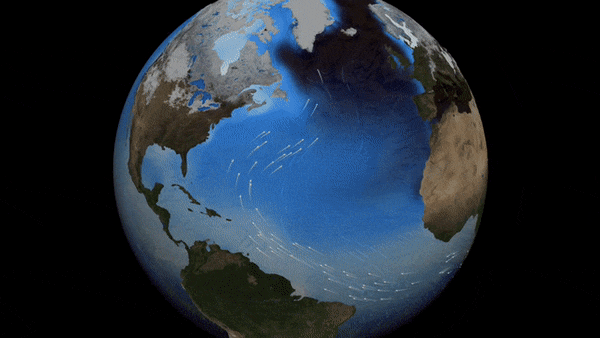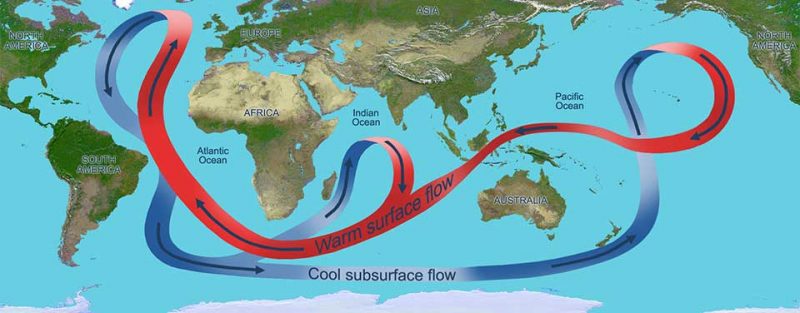

The Gulf Stream plays a vital role in redistributing heat throughout our planet’s climate system. This animation shows the Gulf Stream sending warm water to the North Atlantic Ocean, forcing colder water to sink and travel southward. Image via NASA/ Goddard Space Flight Center Scientific Visualization Studio/ SciJinks.
The Gulf Stream, the Atlantic ocean current system that plays a vital role in redistributing heat throughout our planet, is the weakest it’s been in at least 1,600 years. That’s according a new study, published February 25, 2021 in the peer-reviewed journal Nature Geoscience by a team of scientists from Ireland, Britain and Germany. The researchers say the slowdown is likely linked to human-caused climate change.
The researchers compiled so-called proxy data – taken mainly from ice cores, ocean sediments, and corals, as well as from historical data, for instance from ship logs – reaching back many hundreds of years to reconstruct the Gulf Stream’s flow history. They found consistent evidence that its slowdown in the 20th century is unprecedented in the past millennium. Read more about how the scientists conducted their research.
The Gulf Stream – also known as the Atlantic Meridional Overturning Circulation (AMOC) – helps move heat around the planet. The giant ocean circulation influences the climate of the east coast of North America from Florida to Newfoundland, and the west coast of Europe. Stefan Rahmstorf from the Potsdam Institute for Climate Impact Research, lead author of the study, said in a statement:
The Gulf Stream System works like a giant conveyor belt, carrying warm surface water from the equator up north, and sending cold, low-salinity deep water back down south. It moves nearly 20 million cubic meters of water per second, almost a hundred times the Amazon flow.
What might be the consequences, looking ahead? Rahmstorf told The Guardian:
In 20 to 30 years it is likely to weaken further, and that will inevitably influence our weather, so we would see an increase in storms and heatwaves in Europe, and sea level rises on the east coast of the U.S.

The Gulf Stream to the west of Ireland continues as the North Atlantic Current. Image via RedAndr/ Wikipedia.
Rahmstorf said:
We have combined a range of previous studies and found they provide a consistent picture of the AMOC evolution over the past 1,600 years. The study results suggest that it has been relatively stable until the late 19th century. With the end of the Little Ice Age in about 1850, the ocean currents began to decline, with a second, more drastic decline following since the mid-20th century.

View larger. | The great ocean conveyor moves water around the globe. Cold, salty water is dense and sinks to the bottom of the ocean while warm water is less dense and remains on the surface. Image via NOAA.
Why is the Gulf Steam slowing down? According to a number of studies, global warming is likely the reason for the observed weakening. According the a statement from the Potsdam Institute for Climate Impact Research:
The Atlantic overturning is triggered by the differences in the density of the ocean water: Warm and salty water moves from the south to the north where it cools down and thus gets denser. When it is heavy enough the water sinks to deeper ocean layers and flows back to the south. Global warming disturbs this mechanism. Increased rainfall and enhanced melting of the Greenland Ice Sheet add fresh water to the surface ocean. This reduces the salinity and thus the density of the water, inhibiting the sinking and thus weakening the flow of the AMOC.
The consequences of the Gulf Stream’s slowdown could be manifold for people living on both sides of the Atlantic. Levke Caesar of the Irish Climate Analysis and Research Unit at Maynooth University is a study co-author. Caesar said:
The northward surface flow of the AMOC leads to a deflection of water masses to the right, away from the U.S. east coast. This is due to Earth’s rotation that diverts moving objects such as currents to the right in the Northern Hemisphere and to the left in the Southern Hemisphere. As the current slows down, this effect weakens and more water can pile up at the U.S. east coast, leading to an enhanced sea level rise.
In Europe, said the researchers, a further slowdown of the AMOC could imply more extreme weather events, for example a change of the winter storm track coming off the Atlantic, possibly intensifying the storms. Other studies found possible consequences such as extreme heat waves or a decrease in summer rainfall.
Scientists can’t say for sure what the further consequences might be. But, Rahmstorf said:
If we continue to drive global warming, the Gulf Stream System will weaken further, by 34 to 45% by 2100 according to the latest generation of climate models. This could bring us dangerously close to the tipping point at which the flow becomes unstable.
Bottom line: The Gulf Stream, an Atlantic Ocean current that plays a large role in shaping Earth’s weather patterns,is weaker now than at any point in the last 1,000 years according to a new study.
Source: Current Atlantic Meridional Overturning Circulation weakest in last millennium
Via Potsdam Institute for Climate Impact Research
Still a few 2021 lunar calendars available. Order yours before they’re gone!
from EarthSky https://ift.tt/3uJWRYR


The Gulf Stream plays a vital role in redistributing heat throughout our planet’s climate system. This animation shows the Gulf Stream sending warm water to the North Atlantic Ocean, forcing colder water to sink and travel southward. Image via NASA/ Goddard Space Flight Center Scientific Visualization Studio/ SciJinks.
The Gulf Stream, the Atlantic ocean current system that plays a vital role in redistributing heat throughout our planet, is the weakest it’s been in at least 1,600 years. That’s according a new study, published February 25, 2021 in the peer-reviewed journal Nature Geoscience by a team of scientists from Ireland, Britain and Germany. The researchers say the slowdown is likely linked to human-caused climate change.
The researchers compiled so-called proxy data – taken mainly from ice cores, ocean sediments, and corals, as well as from historical data, for instance from ship logs – reaching back many hundreds of years to reconstruct the Gulf Stream’s flow history. They found consistent evidence that its slowdown in the 20th century is unprecedented in the past millennium. Read more about how the scientists conducted their research.
The Gulf Stream – also known as the Atlantic Meridional Overturning Circulation (AMOC) – helps move heat around the planet. The giant ocean circulation influences the climate of the east coast of North America from Florida to Newfoundland, and the west coast of Europe. Stefan Rahmstorf from the Potsdam Institute for Climate Impact Research, lead author of the study, said in a statement:
The Gulf Stream System works like a giant conveyor belt, carrying warm surface water from the equator up north, and sending cold, low-salinity deep water back down south. It moves nearly 20 million cubic meters of water per second, almost a hundred times the Amazon flow.
What might be the consequences, looking ahead? Rahmstorf told The Guardian:
In 20 to 30 years it is likely to weaken further, and that will inevitably influence our weather, so we would see an increase in storms and heatwaves in Europe, and sea level rises on the east coast of the U.S.

The Gulf Stream to the west of Ireland continues as the North Atlantic Current. Image via RedAndr/ Wikipedia.
Rahmstorf said:
We have combined a range of previous studies and found they provide a consistent picture of the AMOC evolution over the past 1,600 years. The study results suggest that it has been relatively stable until the late 19th century. With the end of the Little Ice Age in about 1850, the ocean currents began to decline, with a second, more drastic decline following since the mid-20th century.

View larger. | The great ocean conveyor moves water around the globe. Cold, salty water is dense and sinks to the bottom of the ocean while warm water is less dense and remains on the surface. Image via NOAA.
Why is the Gulf Steam slowing down? According to a number of studies, global warming is likely the reason for the observed weakening. According the a statement from the Potsdam Institute for Climate Impact Research:
The Atlantic overturning is triggered by the differences in the density of the ocean water: Warm and salty water moves from the south to the north where it cools down and thus gets denser. When it is heavy enough the water sinks to deeper ocean layers and flows back to the south. Global warming disturbs this mechanism. Increased rainfall and enhanced melting of the Greenland Ice Sheet add fresh water to the surface ocean. This reduces the salinity and thus the density of the water, inhibiting the sinking and thus weakening the flow of the AMOC.
The consequences of the Gulf Stream’s slowdown could be manifold for people living on both sides of the Atlantic. Levke Caesar of the Irish Climate Analysis and Research Unit at Maynooth University is a study co-author. Caesar said:
The northward surface flow of the AMOC leads to a deflection of water masses to the right, away from the U.S. east coast. This is due to Earth’s rotation that diverts moving objects such as currents to the right in the Northern Hemisphere and to the left in the Southern Hemisphere. As the current slows down, this effect weakens and more water can pile up at the U.S. east coast, leading to an enhanced sea level rise.
In Europe, said the researchers, a further slowdown of the AMOC could imply more extreme weather events, for example a change of the winter storm track coming off the Atlantic, possibly intensifying the storms. Other studies found possible consequences such as extreme heat waves or a decrease in summer rainfall.
Scientists can’t say for sure what the further consequences might be. But, Rahmstorf said:
If we continue to drive global warming, the Gulf Stream System will weaken further, by 34 to 45% by 2100 according to the latest generation of climate models. This could bring us dangerously close to the tipping point at which the flow becomes unstable.
Bottom line: The Gulf Stream, an Atlantic Ocean current that plays a large role in shaping Earth’s weather patterns,is weaker now than at any point in the last 1,000 years according to a new study.
Source: Current Atlantic Meridional Overturning Circulation weakest in last millennium
Via Potsdam Institute for Climate Impact Research
Still a few 2021 lunar calendars available. Order yours before they’re gone!
from EarthSky https://ift.tt/3uJWRYR

Aucun commentaire:
Enregistrer un commentaire